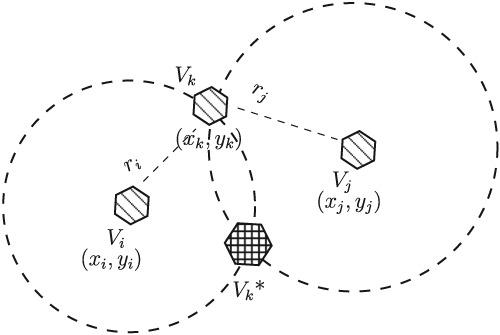当前位置:
X-MOL 学术
›
Int. J. Commun. Syst.
›
论文详情
Our official English website, www.x-mol.net, welcomes your feedback! (Note: you will need to create a separate account there.)
Comparative node selection‐based localization technique for wireless sensor networks: A bilateration approach
International Journal of Communication Systems ( IF 2.1 ) Pub Date : 2020-08-03 , DOI: 10.1002/dac.4559 Nikhath Tabassum 1 , Geetha D. Devanagavi 1 , Rajashekhar C. Biradar 1 , Mihai T. Lazarescu 2
International Journal of Communication Systems ( IF 2.1 ) Pub Date : 2020-08-03 , DOI: 10.1002/dac.4559 Nikhath Tabassum 1 , Geetha D. Devanagavi 1 , Rajashekhar C. Biradar 1 , Mihai T. Lazarescu 2
Affiliation

|
Wireless sensor networks find extensive applications, such as environmental and smart city monitoring, structural health, and target location. To be useful, most sensor data must be localized. We propose a node localization technique based on bilateration comparison (BACL) for dense networks, which considers two reference nodes to determine the unknown position of a third node. The mirror positions resulted from bilateration are resolved by comparing their coordinates with the coordinates of the reference nodes. Additionally, we use network clustering to further refine the location of the nodes. We show that BACL has several advantages over Energy Aware Co‐operative Localization (EACL) and Underwater Recursive Position Estimation (URPE): (1) BACL uses bilateration (needs only two reference nodes) instead of trilateration (that needs three reference nodes), (2) BACL needs reference (anchor) nodes only on the field periphery, and (3) BACL needs substantially less communication and computation. Through simulation, we show that BACL localization accuracy, as root mean square error, improves by 53% that of URPE and by 40% that of EACL. We also explore the BACL localization error when the anchor nodes are placed on one or multiple sides of a rectangular field, as a trade‐off between localization accuracy and network deployment effort. Best accuracy is achieved using anchors on all field sides, but we show that localization refinement using node clustering and anchor nodes only on one side of the field has comparable localization accuracy with anchor nodes on two sides but without clustering.
中文翻译:

无线传感器网络基于比较节点选择的定位技术:双向方法
无线传感器网络可找到广泛的应用,例如环境和智能城市监控,结构健康以及目标位置。为了有用,必须将大多数传感器数据本地化。针对密集网络,我们提出了一种基于双边比较(BACL)的节点定位技术,该技术考虑了两个参考节点来确定第三个节点的未知位置。通过将双边测量结果生成的镜像位置通过将其坐标与参考节点的坐标进行比较来解析。此外,我们使用网络群集进一步完善节点的位置。我们证明,与能源感知合作定位(EACL)和水下递归位置估计(URPE)相比,BACL具有多个优势:(1)BACL使用双向(仅需要两个参考节点)而不是三边测量(需要三个参考节点),(2)BACL仅在场外围需要参考(锚定)节点,(3)BACL需要的通信量大大减少,并且计算。通过仿真,我们表明,作为均方根误差的BACL定位精度,与URPE相比提高了53%,与EACL相比提高了40%。当定位节点位于矩形字段的一侧或多侧时,我们还将探索BACL定位错误,这是在定位精度和网络部署工作之间进行权衡的问题。通过在所有田野两侧使用锚来获得最佳精度,
更新日期:2020-08-03
中文翻译:

无线传感器网络基于比较节点选择的定位技术:双向方法
无线传感器网络可找到广泛的应用,例如环境和智能城市监控,结构健康以及目标位置。为了有用,必须将大多数传感器数据本地化。针对密集网络,我们提出了一种基于双边比较(BACL)的节点定位技术,该技术考虑了两个参考节点来确定第三个节点的未知位置。通过将双边测量结果生成的镜像位置通过将其坐标与参考节点的坐标进行比较来解析。此外,我们使用网络群集进一步完善节点的位置。我们证明,与能源感知合作定位(EACL)和水下递归位置估计(URPE)相比,BACL具有多个优势:(1)BACL使用双向(仅需要两个参考节点)而不是三边测量(需要三个参考节点),(2)BACL仅在场外围需要参考(锚定)节点,(3)BACL需要的通信量大大减少,并且计算。通过仿真,我们表明,作为均方根误差的BACL定位精度,与URPE相比提高了53%,与EACL相比提高了40%。当定位节点位于矩形字段的一侧或多侧时,我们还将探索BACL定位错误,这是在定位精度和网络部署工作之间进行权衡的问题。通过在所有田野两侧使用锚来获得最佳精度,


























 京公网安备 11010802027423号
京公网安备 11010802027423号